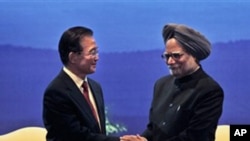China and India are the two most populous nations in the world, and combined represent the biggest market for growth and opportunities in the world.
As the large Asian nations become more prominent in global economics, security and other issues, the United States is trying to maintain a positive balance in relations between the two countries that have a lot of room to strenghten ties with each other. The new century has been dominated with the growing trend of Asian influence.
"As the rise of Germany defined the 19th century and the rise of the United States defined the 20th century, the rise of China and India as global players will transform the geopolitical landscape of the 21st century," said Robert Hormats, the U.S. Under Secretary of State for Economic, Energy, and Agricultural Affairs. "So we are moving from a trans-Atlantic century to a trans-Pacific century, and China and India are smack in the middle of that."
Speaking Wednesday in Washington at the Center for Strategic and International Studies (CSIS), Under Secretary Hormats says the United States has been learning how to balance relations with both countries as ties with India grow stronger.
"How to manage this triangular relationship in a cooperative and not a competitive way is going to be very important. China has been watching very carefully the rise of the U.S.-India relationship, including on the defense side. We do more maneuvers now with the Indian army than they do with any other country," he said.
In many aspects, the direct relationship between China and India has been difficult. A large stretch of the Himalayan border is disputed and contentious. Ed Luce, a Senior Commentator with The Financial Times, says that has helped to stifle the flow of people crossing between the two countries, limiting direct contact and knowledge of each other.
"The number of visas issued each year are still tiny if you consider that they border each other and they are massive. They are the world's two most populous countries. So the potential for misunderstanding is great," he said.
Under Secretary Hormats says the climate for misunderstandings presents a potentially delicate diplomatic situation for the United States. "India wants good relations with China because they know they are neighbors and they know that they are both nuclear weapons states and they want to trade. They do not want to get caught up in a machination of U.S.-China," he said.
As in most national relationships, economic prosperity and growth often determine actions between countries. Because of that, Ed Luce does not think that China and India are on a collision course toward conflict.
"There is a mutual wariness there. All the while, economic ties between the two countries are flourishing. So it is a much more complex picture than just the one you would get if you looked at the strategic realm. And both countries very explicitly see their core national security and trust as economic growth. And the one thing that would kill that would be conflict. So I do not think they are destined for any kind of conflict," he said.
That leaves the United States in the position to help foster a climate where both China and India can prosper by growing into the established practices of western nations which have flourished over the past century.
Ambassador Karl F. Inderfurth, a Senior Advisor at CSIS and a former U.S. Assistant Secretary of State for South Asian Affairs, said "One of the ways we should be and are trying to shape their policies is to encourage them to adhere to a greater degree to global rules when it comes to trade or when it comes to investment or when it comes to a way intellectual property is protected because these countries have a growing stake in the global economy."
Ambassador Inderfurth says U.S. expertise in technology presents a unique way to strengthen ties with India to the point of engaging average citizens.
"One of the most intriguing elements of the relationship is how we can use the high tech cooperation that the United States and India are developing in a way that benefits the average Indian on the farms and the villages throughout India. By the same token, one of the things we have tried to do in the United States is to demonstrate to Americans that they benefit from this economic relationship with India," he said.
That deeper understanding of direct benefits he says will help to alleviate some concerns in the United States, where many jobs have been outsourced to other countries, notably India.









